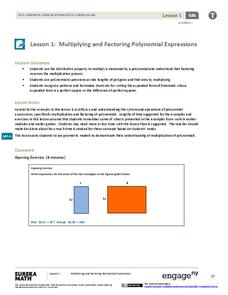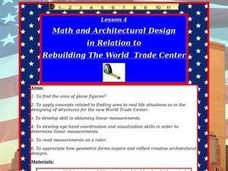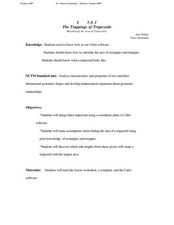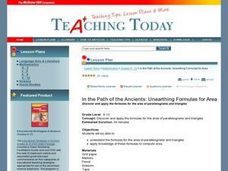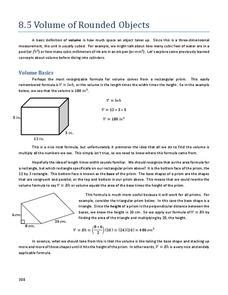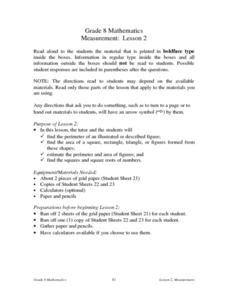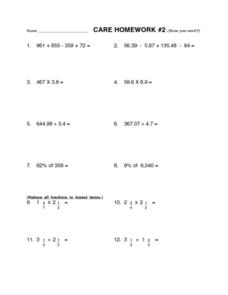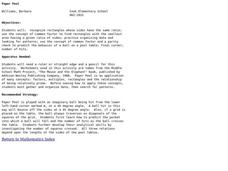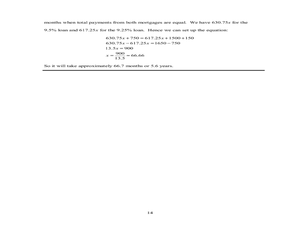Curated OER
Sides of squares
In this sides of squares worksheet, students find the sides of a square whose areas are given. Students complete 4 problems total.
EngageNY
Multiplying and Factoring Polynomial Expressions (part 1)
Polynomial multiplication and factoring go hand in hand. Why not teach them together. This resource begins with an area model for distributing a monomial and then connects the process to factoring the GCF. Learners then advance to...
Math Mammoth
Expressions
In this expression worksheet, learners evaluate equations, write equations for a specified event, and determine the perimeter of shapes, Six multi-step problems are provided on this one-page worksheet.
Curated OER
Math and Architectural Design in Relation to Rebuilding The World Trade Center
Students discover building plans and practice reading measurements. For this architectural design lesson, students investigate the areas of the specific World Trade Center locations that need to be rebuilt and determine the cost....
Curated OER
The Trappings of Trapezoids
Pupils define trapezoids and their shapes. In this geometry instructional activity, students calculate the area of a trapezoid and a parallelogram. They use Cabri software to make investigations.
Curated OER
In the Path of the Ancients: Unearthing Formulas for Area
Students apply the formulas for the area of parallelograms and triangles. Through guided practice, students discover the correct way to apply the formulas. Working in pairs, they write their own problems featuring the formulas.
Curated OER
The Old Chicken Run Problem
Sixth graders apply problem solving strategies to work with a real life situation in which they need to determine the area. They determine the area of chicken runs that are rectangular in shape when give a partial perimeter.
Mathematics Vision Project
Module 5: Modeling with Geometry
Solids come in many shapes and sizes. Using geometry, scholars create two-dimensional cross-sections of various three-dimensional objects. They develop the lesson further by finding the volume of solids. The module then shifts...
Charleston School District
Volume of Rounded Objects
How much can different shapes hold? The answer varies depending on the shape and dimensions. Individuals learn the formulas for the volume of a sphere, cone, and cylinder. They apply the formulas to find the volume of these...
Curated OER
Connecting Algebra and Geometry Through Coordinates
This unit on connecting algebra and geometry covers a number of topics including worksheets on the distance formula, finding the perimeter and area of polynomials, the slope formula, parallel and perpendicular lines, parallelograms,...
National Park Service
Fitting In
Birds help other birds find food? Scholars are placed into one of five groups of different birds. Each group then "feeds" on letters of paper in a field and gather five pieces per person. As each group plays, more food is exposed,...
Curated OER
Division by Fractions (Part Two)
Investigate division through the use of array models. The lesson plan focuses on using area models to compare division as sharing with division as grouping. Students evaluate the usefulness and limitations of the two array models.
Balanced Assessment
Multi-Figures
Apply concepts of scale and ratio to determine relationships in irregular figures. Learners determine the ratio of the perimeters of two figures composed of rectangles and circles. After, they apply similar concepts to find the ratio of...
Curated OER
Writing Organizers
Eight graphic organizers to choose from? That's right! Each of these organizers relates to writing or reading. From narrowing a writing topic, to responding to literature, to planning a writing project, you'll find many purposes for...
Balanced Assessment
On Averages and Curves
Determine the average on a curve. The class finds graphical representations of averages and expresses them both symbolically and on the graph. The assessment requires class members to justify using average to describe graphs.
Curated OER
Area of Parallelograms
Seventh graders review the process of finding the area of a rectangle and complete a couple of examples as a class. They discuss what a parallelogram is and what the formula would be for finding its area. They listen to an explanation...
Curated OER
Measurement: Lesson 2
Fourth graders find the perimeter of a geometric shape by adding the lengths of the sides. They find the area of a square or rectangle by counting square units. Students use multiplication to find the area of a rectangle. They estimate...
Curated OER
Geometric Figures
Students compare, classify and calculate the area of geometric figures such as rectangles, squares, circles and triangles.
Curated OER
Minimize Perimeter
Middle schoolers practice calculating the perimeter of different sized rectangles. Individually, they identify the derivations of a function that can show the perimeter and determine how to minimize the perimeter within a fixed area....
Curated OER
Minimize Perimeter -- Lecture
Learners are introduced to the concept of perimeter. As a class, they listen to a lecture describing the derivations of a function that describes perimeter. They calculate the minimum perimeter of a rectangle and determine the numbers...
Curated OER
Care Homework #2
In this Care Homework worksheet, students solve a variety of multiple digit addition, subtraction, multiplication, and division problems that include fractions, decimals, and percentages. They demonstrate knowledge of geometric formulas...
Curated OER
Paper Pool
Students analyze the measurements of rectangles. In this analysis lesson, students will investigate patterns by looking at ratios. Students will also hypothesize the probability of a ball going into a certain pocket when playing pool....
Curated OER
Topics in Math
In this consumer mathematics worksheet, students explore a variety of topics in mathematics including simple interest, perimeter, area, volume, translating words into symbols, percentage problems and mortgage calculations. The fourteen...
Curated OER
Interior Designer for a Day
Seventh graders organize a 20 x 17 room with a given set of furniture pieces. Arrangement is to be based on maximum comfort and practicality. This lesson plan is a good way to teach and reinforce the mathematical concept of area.



